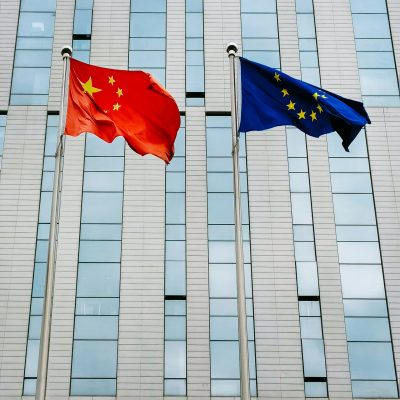[EN] Cartographie du commerce numérique de l’UE
A global leader hidden in plain sight?

Recommended citation
Köhler-Suzuki N. 2023. « Mapping the EU’s digital trade. A global leader hidden in plain sight?« , Policy paper, Paris: Jacques Delors Institute, July.
- Introduction
The pandemic has moved our work and life online and accelerated the European Union’s transition towards a digital economy. Surveys show that up to three quarters of European employees would like to continue teleworking in the future.[1] Digital networks deliver video to the 141 million Europeans that are subscribing to streaming services for entertainment.[2] Moreover, the volume of physical goods that businesses and consumers order online has increased by 58% in 2020 alone.[3] Such developments are deeply altering the structure of the European economy and have become important drivers for productivity.[4] At the same time, the center of the world economy is shifting east. The European Commission estimates that 85% of future economic growth will take place outside of the EU–and much of it in the digital sector.[5] It is therefore crucial that the EU connects with the markets of the future, so that Europe remains at the forefront of the digital transformation.
A widely held view is that the EU currently tries to make up for shortcomings in its digital economy with excessive regulation against foreign competition. French President Emmanuel Macron summarized this predicament, when he wrote in 2020 that the US has the GAFA (in reference to Google, Apple, Facebook, and Amazon) and China the BATX (in reference to Baidu, Alibaba, Tencent, and Xiaomi), but the EU only the GDPR (in reference to the General Data Protection Regulation).[6] Although Europe only has few large technology companies with a market capitalization that approaches the largest American and Chinese platforms, this narrative may at the same time be short selling an important strength that is hidden in plain view: the EU’s central role in the emerging digital trade regime as the world’s leading exporter and importer of digitally deliverable services and a key player in the quickly developing regulatory sphere for digital trade.
In fact, as the data in the analysis below shows, the EU exports and imports more digitally deliverable services than other leading economies, such as the United States, China, or India. On the one hand, this means that the EU must safeguard the market access interests of its firms–and perhaps do so more aggressively than it has in the recent past. On the other hand, its leading role as an importer of digitally deliverable services can help to explain the ‘Brussels effect’ in the global digital economy.[7]
With its recent privacy, platform, competition and data regulations, the EU has been responding to the functional demands that arise in a globally integrated digital economy, which grew around a largely self-regulated internet. The lack of rules allowed for rapid growth and development, but it has also raised questions about the appropriate role of government as data crossing international borders creates externalities and regulatory gaps. Consumers, for example, are worried about their privacy if personal data are stored outside of their jurisdiction. Businesses must deal with digital market access barriers when trying to sell their goods and services across borders. EU trade policy is not a new tool to address such gaps. The EU has therefore included digital trade provisions in its trade agreements as far back as 2001 and in a total of twenty-four agreements to date, continuously expanding their scope and scale over the years. The 2021 EU Trade Policy Review, which is guiding the current European trade agenda, also recognizes the role of trade policy in the digital economy:
‘the digital transformation is [a] key enabler of sustainable development, but also a space of competition and inadequate multilateral governance. As it embarks on its Digital Decade, supporting Europe’s digital transformation is a priority both in internal and external policies including trade policy and instruments.’[8]
This indicates that EU trade policy will continue to increasingly address cross-border transactions in the digital realm, which can be subsumed under the emerging ‘digital trade’ paradigm.
Discussions around digital trade developed in the early 2010s from the non-binding internet governance agenda and the long-dormant e-commerce work program of the WTO and have seen rapid advances in recent years.[9] Despite this, policymakers still have a somewhat fuzzy understanding of digital trade, both in terms of its definition and measurement. While the EU Commission is beginning to take the need for a digital trade strategy more seriously, the member states must quickly improve their understanding about Europe’s strengths in digital trade and how to use them as a leverage in promoting its regulatory model for the digital economy.
This policy paper contributes to the evolving debate by attempting to map the size and direction of the European Union’s digital trade and analyzing recent European efforts to regulate cross-border digital flows in trade agreements and a new generation of digital partnerships.
Notes
[1] Eurofound, 2021, Working during COVID-19.
[2] The Hollywood Reporter 2021, European Streaming Market Tops $14 Billion, Netflix, Amazon Dominate.
[3] Estimates by Oscar de Bok, Global chief executive officer, DHL Supply Chain, at the World Trade Symposium 2021.
[4] See in particular the work of the OECD on this topic.
[5] European Commission, 2021, Trade Policy Review – An Open, Sustainable and Assertive Trade Policy
[6] Emmanuel Macron, 2021, LinkedIn post on European technological sovereignty.
[7] Anu Bradford, 2020, The Brussels effect: How the European Union rules the world. Oxford University Press, Oxford.
[8] European Commission (2021) Trade Policy Review – An Open, Sustainable and Assertive Trade Policy.
[9] Shamel Azmeh, Christopher Foster, Jaime Echavarri, The International Trade Regime and the Quest for Free Digital Trade, International Studies Review, Volume 22, Issue 3, September 2020, pp. 671–692.




